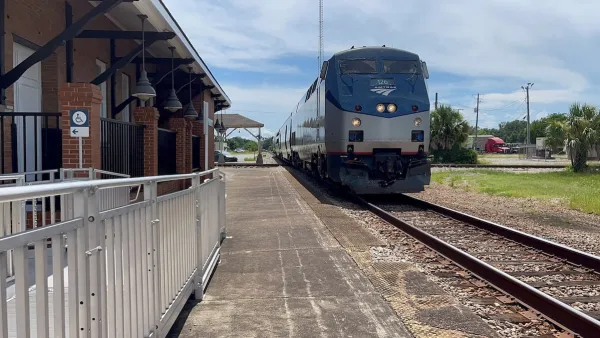GOOD Magazine sends a reporter across country on Amtrak to give a riders-eye view of the system.
"With no rush about me, here I was, on a trip from New York to San Francisco that runs exactly 3,397 miles, rolling through 11 states, on two legendary rail routes-the Lake Shore Limited (from New York to Chicago) and the California Zephyr (from Chicago to just outside San Francisco). This could take exactly 77 hours and 15 minutes, if the trains keep to schedule. Most likely, they won't.
The American passenger rail-once a model around the globe-is now something of an oddball novelty, a political boondoggle to some, a colossal transit failure to others. The author James Howard Kunstler likes to say that American trains "would be the laughing stock of Bulgaria." The numbers show just how far this once-great system has fallen. In 1960, U.S. rail travelers logged 17.1 billion passenger miles (the movement of one passenger one mile), the standard measure of a system's reach; by 2000, that number had fallen to 5.5 billion, just one percent of the total travel between U.S. cities that year. (Of course, over this same period, airlines' passenger miles increased 16 times; even intercity buses' service nearly doubled.) Most of this decrease was seen in the 1960s, as highways and air travel took precedent both in travel plans and in government subsidies. Since its ill-fated formation as a quasi-public, for-profit corporation in 1971, Amtrak has seen only meager growth and loses billions of dollars annually."
FULL STORY: Train in Vain

Maui's Vacation Rental Debate Turns Ugly
Verbal attacks, misinformation campaigns and fistfights plague a high-stakes debate to convert thousands of vacation rentals into long-term housing.

Planetizen Federal Action Tracker
A weekly monitor of how Trump’s orders and actions are impacting planners and planning in America.

San Francisco Suspends Traffic Calming Amidst Record Deaths
Citing “a challenging fiscal landscape,” the city will cease the program on the heels of 42 traffic deaths, including 24 pedestrians.

Defunct Pittsburgh Power Plant to Become Residential Tower
A decommissioned steam heat plant will be redeveloped into almost 100 affordable housing units.

Trump Prompts Restructuring of Transportation Research Board in “Unprecedented Overreach”
The TRB has eliminated more than half of its committees including those focused on climate, equity, and cities.

Amtrak Rolls Out New Orleans to Alabama “Mardi Gras” Train
The new service will operate morning and evening departures between Mobile and New Orleans.
Urban Design for Planners 1: Software Tools
This six-course series explores essential urban design concepts using open source software and equips planners with the tools they need to participate fully in the urban design process.
Planning for Universal Design
Learn the tools for implementing Universal Design in planning regulations.
Heyer Gruel & Associates PA
JM Goldson LLC
Custer County Colorado
City of Camden Redevelopment Agency
City of Astoria
Transportation Research & Education Center (TREC) at Portland State University
Jefferson Parish Government
Camden Redevelopment Agency
City of Claremont



























